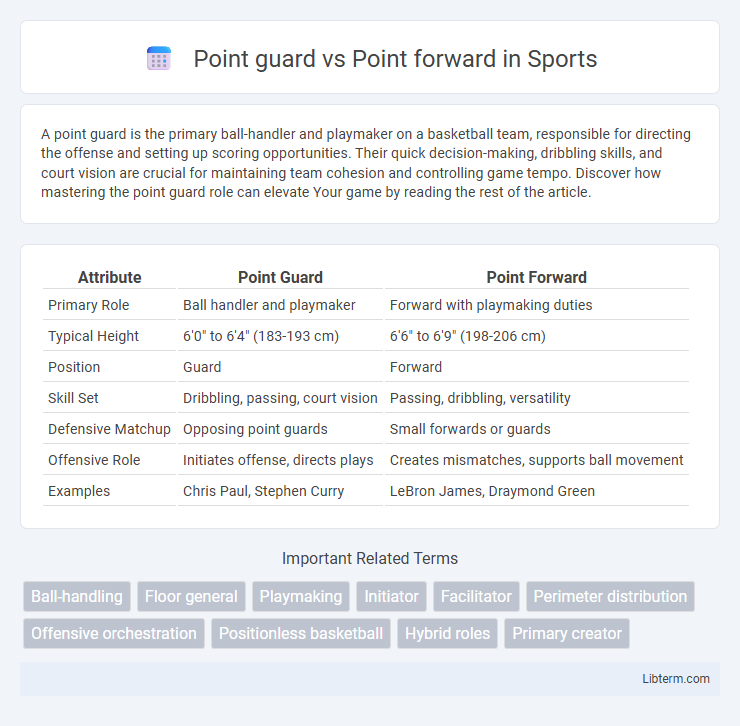A point guard is the primary ball-handler and playmaker on a basketball team, responsible for directing the offense and setting up scoring opportunities. Their quick decision-making, dribbling skills, and court vision are crucial for maintaining team cohesion and controlling game tempo. Discover how mastering the point guard role can elevate Your game by reading the rest of the article.
Table of Comparison
| Attribute | Point Guard | Point Forward |
|---|---|---|
| Primary Role | Ball handler and playmaker | Forward with playmaking duties |
| Typical Height | 6'0" to 6'4" (183-193 cm) | 6'6" to 6'9" (198-206 cm) |
| Position | Guard | Forward |
| Skill Set | Dribbling, passing, court vision | Passing, dribbling, versatility |
| Defensive Matchup | Opposing point guards | Small forwards or guards |
| Offensive Role | Initiates offense, directs plays | Creates mismatches, supports ball movement |
| Examples | Chris Paul, Stephen Curry | LeBron James, Draymond Green |
Introduction to Point Guard and Point Forward Roles
The point guard is a primary ball-handler and playmaker responsible for orchestrating the offense, often leading the team in assists and controlling the game's tempo. A point forward combines the responsibilities of a forward with the playmaking skills of a point guard, creating mismatches and facilitating scoring opportunities from a versatile position. Both roles require high basketball IQ, court vision, and the ability to read defenses effectively.
Historical Evolution of Positions
The historical evolution of basketball positions highlights the transition from traditional point guards, known for ball-handling and playmaking, to the emergence of point forwards who blend forward size with guard skills, revolutionizing offensive strategies. This shift began in the 1980s and 1990s with players like Magic Johnson and Scottie Pippen, who redefined positional roles by facilitating offense from the forward spot. The development reflects broader changes in basketball emphasizing versatility, pace, and mismatches, leading to today's positionless basketball trends.
Key Responsibilities on the Court
Point guards orchestrate the offense by directing plays, distributing the ball, and setting the tempo while also applying perimeter defense to disrupt opposing guards. Point forwards blend the traditional point guard's ball-handling and playmaking skills with the size and versatility of a forward, often creating mismatches by facilitating scoring opportunities from multiple positions. Both roles demand high basketball IQ, court vision, and the ability to read defenses to optimize team performance.
Skill Sets Comparison
Point guards excel in ball handling, court vision, and playmaking, orchestrating the offense with precise passing and quick decision-making. Point forwards combine the size and versatility of forwards with guard-like skills, offering effective ball handling, scoring ability, and defensive versatility to initiate plays. While point guards prioritize speed and agility, point forwards leverage size and strength to create mismatches and facilitate inside-out offense.
Physical Attributes and Requirements
Point guards typically possess exceptional agility, quickness, and ball-handling skills, requiring a smaller, leaner frame to navigate tight defenses and execute fast breaks efficiently. Point forwards combine the size and strength of a forward with the playmaking abilities of a guard, demanding greater height, physicality, and versatility to operate both inside the paint and at the perimeter. While point guards rely on speed and precision, point forwards require a balance of strength, court vision, and endurance to manage multiple roles effectively.
Playmaking and Leadership Styles
Point guards excel in orchestrating the offense with precise ball handling, court vision, and quick decision-making, often setting the tempo and directing teammates through structured plays. Point forwards blend the traditional forward's scoring and rebounding skills with playmaking responsibilities, using versatility and size advantage to create mismatches and facilitate ball movement from the wing or post. Leadership from point guards typically centers on vocal direction and command, while point forwards lead through adaptable strategies and on-court versatility, influencing team dynamics with their multifaceted roles.
Defensive Duties and Matchups
Point guards typically defend opposing guards, requiring quick lateral movement, strong perimeter awareness, and the ability to navigate screens against primary ball handlers. Point forwards, often larger and more versatile, match up defensively against wing forwards or smaller forwards, leveraging size and strength to guard multiple positions and contest post plays. Defensive duties for point forwards emphasize switchability and physicality, while point guards rely on agility and anticipation to disrupt playmaking.
Impact on Team Offense and Spacing
A point guard directs the offense by orchestrating plays, controlling ball distribution, and creating scoring opportunities through perimeter passing, which enhances team spacing by drawing defenders out to the perimeter. A point forward combines the ball-handling and playmaking skills of a guard with the size and versatility of a forward, often creating mismatches by facilitating offense from a position closer to the basket, which can disrupt traditional defensive schemes and open up driving lanes. Both roles significantly impact team offense and spacing, with the point guard emphasizing perimeter facilitation and spacing, while the point forward adds versatility and unpredictability in offensive sets.
Famous Point Guards vs Point Forwards in NBA History
Legendary point guards like Magic Johnson and Chris Paul are known for their exceptional ball-handling, court vision, and playmaking skills, orchestrating offense with precision. Iconic point forwards such as LeBron James and Scottie Pippen revolutionized the role by combining size and versatility with traditional point guard duties, effectively blending scoring, passing, and defensive capabilities. The NBA history showcases the evolution of these roles, with point guards excelling in speed and control while point forwards offer a unique hybrid of power and playmaking.
Choosing the Right Role: Team Strategy Considerations
Selecting between a point guard and a point forward hinges on team dynamics and strategic goals. Point guards excel in leading fast breaks, orchestrating plays, and enhancing perimeter defense, making them vital for traditional guard-oriented offenses. Point forwards, versatile players who handle playmaking from a forward position, offer height advantages and mismatches, suited for teams emphasizing size, flexibility, and unpredictable offensive schemes.
Point guard Infographic

 libterm.com
libterm.com